American Music Review
Vol. XLII, No. 1, Fall 2012
By Ray Allen
There is certainly no dearth of information on America's most heralded folk singer, Woodrow Wilson Guthrie. Serious students of folk music are familiar with the wealth of published materials devoted to his life and music that have appeared over the past two decades. Ed Cray's superb biography,Ramblin's Man: The Life and Times of Woody Guthrie (W.W. Norton, 2004) provides an essential road map. Mark Allan Jackson's Prophet Singer; The Voice and Vision of Woody Guthrie (University of Mississippi Press, 2007) moves deeper into the songs, while Robert Santelli and Emily Davidson's edited volume, Hard Travelin': The Life and Legacy of Woody Guthrie (Wesleyan University Press, 1999), explores his myriad contributions as a song writer, journalist, and political activist.
Guthrie's recordings abound. His seminal Dust Bowl Ballads collection, originally recorded in April of 1940 for RCA Victor, has been reissued numerous times, most recently in 2000 by Buddha Records. Rounder Records'Woody Guthrie: Library of Congress Recordings, featuring highlights from the hours of singing and storytelling Guthrie recorded for Alan Lomax in March of 1940, was released in 1992. Smithsonian Folkways has produced over a dozen Guthrie compilations, most notably Woody Guthrie: The Asch Recordings, Volumes 1-4, a four CD set which brings together the best of his mid-1940s work with Moe Asch. Guthrie's legendry 1944 performances with Cisco Houston and Sonny Terry have been re-mastered and released in 2009 on Rounder Records four CD collection, Woody Guthrie: My Dusty Road. Beginning in the late 1990s the Guthrie Archives opened its doors to a select group of contemporary singer/songwriters/activists who set his unpublished lyrics to new music—Billy Bragg's 1998 acclaimed Mermaid Avenue and the Klezmatics' 2006 Grammy winning Wonder Wheel are two of the best works to emerge from this ongoing project.
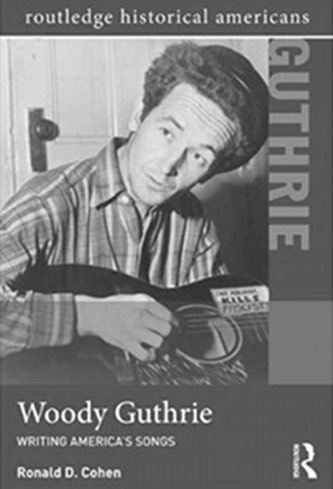
Ronald Cohen, Woody Guthrie: Writing America's Songs (Routledge Press, 2012)
With all this one wonders if anything remains to be said about the man. The sponsors of the 2012 Guthrie Centennial Celebration seemed to think so. In addition to organizing a series of Guthrie conferences and concerts around the country, they encouraged a new surge of Guthrie research and publication. As author Ronald Cohen unashamedly admits in his introduction, Woody Guthrie: Writing America's Songs was timed to coincide with the festivities. The work is a pocket biography, packing Guthrie's life story into three concise chapters. For readers who do not have time to wade through Cray's lengthier tome Cohen delivers the essentials in clear, engaging prose. The most significant contribution is the final chapter, "Woody's Legacy," which traces the construction of the Guthrie mythos by critics, scholars, and fellow musicians over the past forty years. His influence on Bob Dylan, Pete Seeger, and Bruce Springsteen is well known, but rockers Billy Bragg, Tom Morello, and the Dropkick Murphys' adulation for Guthrie demonstrates how his songs continue to resonate with new generations of singers. The work is further enhanced by the inclusion of several choice primary documents, most importantly Pete Seeger's insightful 1963 reminiscence, "Remembering Woody," and Guthrie's introduction to the 1967 volume Hard Hitting Songs for Hard Hit People. The latter is a marvelous collection of Depression-era topical folk songs that Guthrie, at the behest of Alan Lomax and with the help of Pete Seeger, began compiling and annotating in the 1940s. Hard Hitting Songs has been brought back into print by Bison Books (2012), just in time for the centennial.
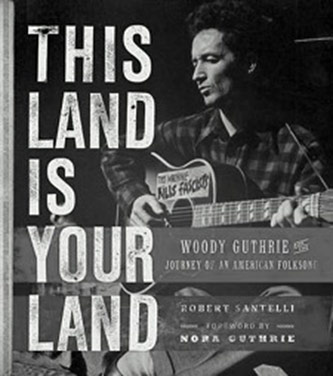
Robert Santelli, This Land is Your Land: Woody Guthrie and the Journey of an American Folk Song (Running Press, 2012)
Robert Santelli of the Grammy Museum and Nora Guthrie of the Guthrie Archives, the two primary organizers of the Guthrie Centennial, have each authored notable works. Santelli's This Land is Your Land: Woody Guthrie and the Journey of an American Folk Song (Running Press, 2012) melds Guthrie's biography with the story of his most famous song. Written in February of 1940, shortly after he had arrived in New York City, "This Land" was allegedly Guthrie's response to Kate Smith's zealously patriotic and astoundingly popular rendition of Irving Berlin's "God Bless America." But the song remained buried in Guthrie's notebook for four years until he recorded it for Moe Asch, who did not release it until 1951 as part of a compilation of children's songs for his new Folkways label. This short version, the one that extolled the wonders of the American landscape but omitted controversial verses condemning private property and empathizing with the hungry victims of corrupt capitalism, was taught to millions of American school kids in the 1950s and 1960s. Santelli recounts the various iterations of the song on record and in print, culminating with the full version, protest verses and all, sung by Pete Seeger and Bruce Springsteen on the steps of the Lincoln Memorial for the 2009 Obama Inauguration. Along the way Santelli introduces us not only to Guthrie and his important associates—Lomax, Seeger, Asch, etc—but also to Kate Smith and Irving Berlin in order to provide meaningful context to the song's origins. The final two chapters trace "This Land" and Guthrie's legacy through the folk music revival of the 1960s, 1970s, and beyond via Dylan and Springsteen. Some scholars will undoubtedly be disappointed by the absence of footnotes, but the Acknowledgments section of the book reveals that Santelli did his homework, basing his account on extensive research in the Guthrie and Asch/Smithsonian Archives and interviews with key family members and musicians. Most importantly, Santelli tells a good story—this is as engaging a read as you will find in any of the serious literature devoted to American folk music.
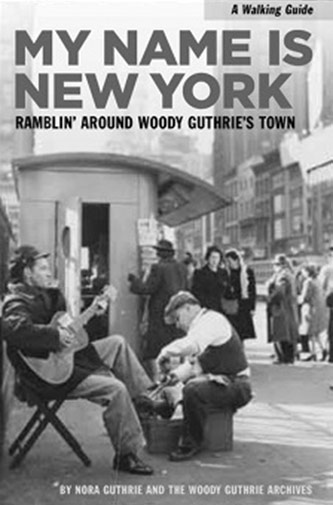
Nora Guthrie, My Name is New York: Ramblin' Around Woody Guthrie's Town (powerHouse Books, 2012)
Nora Guthrie's My Name is New York: Ramblin' Around Woody Guthrie's Town (powerHouse Books, 2012) offers a guided walking tour of nineteen sites where Guthrie resided during his twenty-seven years in New York City. The tour begins at activist/actor Will Geer's former posh 5th Avenue Apartment where Guthrie crashed when he first arrived in New York in February of 1940. Other highlights include the midtown boarding house where he wrote "This Land Is Your Land," the three Greenwich Village Almanac (Singers) houses, and the various Coney Island apartments where he and his second wife, modern dancer Marjorie Mazia, raised their family. These latter sites remind us of Guthrie's unlikely connections to the New York modern arts scene and to Brooklyn's progressive Jewish community via Marjorie and her mother, the renowned Yiddish playwright Aliza Greenblatt. A Coney Island jetty where Guthrie's ashes were sprinkled into the Atlantic Ocean in October of 1967 brings closure to the tour. The work is replete with splendid historical photographs, original song lyrics from the Guthrie Archives, and striking reproductions of Guthrie's drawings. The guide chronicles Guthrie's career as a song writer and activist during the second half of his life, portraying him as one of the few Okie migrants who came to call New York, rather than California, his new home.
While these popular works and biographies lay out the Guthrie grand narrative in ample detail, there is certainly plenty of room for more rigorous analysis. A series of essays, edited by British historian John S. Partington, begins to fill this void. The Life, Music and Thought of Woody Guthrie: A Critical Appraisal (Ashgate, 2011) brings together an international cast of researchers who examine Guthrie's work from a variety of interdisciplinary perspectives. Familiar faces Ed Cray and Ronald Cohen blend history and politics in assessing the influences of folklorist Alan Lomax and activist Will Geer respectively on Guthrie's career. Richard Nate and Will Kaufman explore the effects of New Deal politics and Culture Front Art on Guthrie's philosophy and activism, while Martin Butler traces the emergence of the artist's anti-fascist consciousness. Close reads of Guthrie's hobo songs by Butler and the folk outlaw ballads by D.A. Pointer, along with insightful analyses of contemporary performances of "This Land" by Frank Erik Pointer, bring fresh insight to the construction of Guthrie's iconic and at times contested legacy. Another highlight is Mark Alan Jackson's probing study of Guthrie's modern urban working man, "Jackhammer John," who is deftly positioned within the pantheon of legendary American folk heroes.
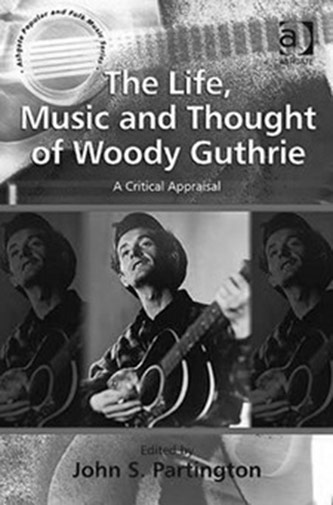
John Partington, The Life, Music and Thought of Woody Guthrie: A Critical Appraisal (Ashgate, 2011)
The Partington collection is not for the uninitiated, as it does not provide an overview of Guthrie's life and achievements, nor is there a single theme that connects the essays. Rather, knowledgeable readers are presented with a series of in-depth case studies from which to pick and choose depending on their interests. Serious students of Guthrie and American folk music will want this book—the contributors to a man (yes, they all are men) exhibit a tremendous command of the primary and secondary literature, and their interpretations dig deep. The only drawback to the volume is the exorbitant $100 dollar price tag which puts it beyond reach for most. Readers can only hope that their local or university library will purchase the book, or that the publishers of Ashgate will eventually come out with a more reasonably priced paper edition of this valuable work.
In December of 1967, two months after Guthrie's death, Sing Out! editor Erwin Silber reminded his readers that Woody was "in the most fundamental sense a totally committed, 24-hour revolutionary determined to turn this whole world upside down." Silber's words were prompted by worries that Guthrie had been deradicalized during the red-baiting years of the McCarthy era that coincided with the surging popularity of the short and politically neutralized version of "This Land." Moreover, while Guthrie had initially been an inspirational anti-establishment figure for protest singers of the early 1960s, Silber fretted that Dylan and other young singers had come to embrace a more abstract and introspective style of songwriting that belied Guthrie's revolutionary mission. These concerns were revisited forty years later by folk singer and professor of American literature Will Kaufman, who turned to the Guthrie Archives and the Library of Congress holdings for answers. The result, Woody Guthrie, American Radical (University of Illinois Press, 2011), is unquestionably the most significant scholarly work to emerge around the Centennial. Surveying his activities, songs, and writings, Kaufman traces the evolution of Guthrie's radical political consciousness from his initial encounters with activists Will Geer and Ed Robbins in California through his association with Alan Lomax, Pete Seeger and the Almanac Singers, and other progressive artists and intellectuals he encountered in New York.
A regular contributor to the communist publication People's World, Guthrie's disgust with capitalism was obvious in songs like "Jesus Christ" that moved beyond the simple description of hardship to a call to arms: "When the patience of the workers gives away/Twould be better for you rich if you'd never been born." His support of left-leaning unions was unwavering, but his attitudes went beyond the call for solidarity echoed in the rousing chorus of his familiar song "Union Maid." As evidence Kaufman presents an unpublished alternative version of the song titled "Union Maid #1," in which Guthrie recounts the brutal sexual assault and beating of African American sharecropperturnedactivist Annie Mae Meriweather that includes the damning chorus:
You have robbed my family and my people,
My Holy Bible says we are equal,
Your money is the root of all our evil,
I know a poor man will win the world.
Guthrie's ire with economic exploitation would eventually parallel his condemnation of racism, a subject to which Kaufman devotes an entire chapter. Contact with activists and African American musicians Lead Belly, Sonny Terry, and Josh White in New York opened up Guthrie's racial consciousness and enabled him to connect the struggles of poor dust bowl Okies to the travails of African American sharecroppers. Kaufman examines a number of Guthrie's lesser-known but powerful antilynching and anti-Jim Crow songs, including "The Ballad of Rosa Lee Ingram" and "Don't Kill my Baby and My Son," the former recounting the horrors of a lynching in Guthrie's home town of Okemah, Oklahoma, the year before he was born.
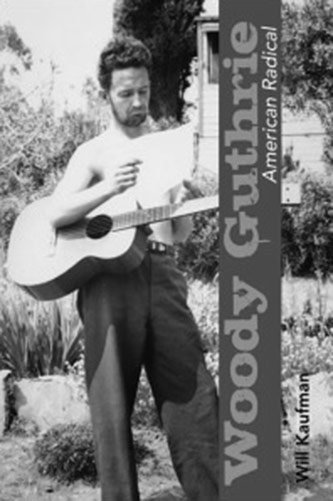
Will Kaufman, Woody Guthrie, American Radical (University of Illinois Press, 2011)
Kaufman is quick to remind readers that despite his scathing critique of American class and racial injustice, Guthrie saw himself as nothing short of a loyal patriot. He was an enthusiastic supporter of World War II, rallying Americans to the cause with his homage to a torpedoed US convoy escort ship titled "The Sinking of the Reuben James," and brazenly condemning fascism with ditties like "Round and Round Hitler's Grave." Guthrie saw no contradiction between being a true-blooded American and a committed socialist; he was a complex and at times paradoxical figure, capable of heart-felt adulation for his country and its working people, but quick to condemn the greed of unfettered capitalism and the corruption of authoritarian big government.
The work concludes with a reflection on the efforts Pete Seeger and others have made to "reassert Guthrie's radical challenge" since his passing in 1967. From established icons like Bruce Springsteen, Bono, and Emmylou Harris to more recent upstarts Tom Morello, Billy Bragg, and the Indigo Girls, scores of artists on both sides of the Atlantic have taken up the call to sing Guthrie's words and channel his spirit in hopes of upsetting an intransigent system that continues to favor the privileged few over the disempowered many.
Some of the terrain Kaufman travels has already been covered by Jackson in the aforementioned work Prophet Singer. But while Jackson's primary focus is the songs themselves, Kaufman offers a broader analysis of Guthrie's politics based on his lyrics (complete songs and unpublished verse), published prose, and unpublished archival writings. Lucidly written and scrupulously sourced, American Radical forces readers to re-imagine Guthrie as both folk poet and revolutionary artist.
Although Guthrie appeared at hundreds of rallies and benefit concerts, recordings of him singing for a live audience are rare. But in 2001 two spools of wire recordings surfaced in a Florida storage closet and were donated to the Guthrie Archives. From these wires sprang the sounds of a 1949 performance Guthrie made in a small auditorium of the Jewish Community Center in Newark, NJ. Highlights of the performance were edited and released by the Guthrie Foundation on a CD entitled The Live Wire, which won a 2008 Grammy for Best Historical Recording. Now the recording, complete with notes by Nora Guthrie and archivist Jorge Arévalo Mateus, has been made more widely available by Rounder Records (2011).
The concert opens with a brief explanation of folk music by Marjorie Mazia who serves as on-stage commentator and interviewer. Guthrie responds to her initial questions by narrating a meandering tale of his childhood in Oklahoma; ten minutes later he gets around to his first song of the evening, a ballad his mother sang to him, "Black Diamond." At Marjorie's prompting he talks about the Texas dust storms and sings "The Great Dust Storm," "Talking Dust Bowl Blues," and "Tom Joad." And so the evening proceeds, with Marjorie introducing various topics and Guthrie responding with rambling stories and songs. The musical performances are loose with Guthrie singing in his signature flat, slightly nasal delivery that plods along, privileging the content of the lyrics over the beauty of the voice. The guitar accompaniment is simple, occasionally slipping out of tune and time. Indeed it is Guthrie the narrator rather than Guthrie the singer or musician who shines on these recordings— wit and wisdom inform his passionate desire to educate his audience about the plight of America's rural poor and working folk who inspired his songs. Previously unheard is Marjorie's delightfully informative voice, striving to channel her husband's songs and narrations into a coherent stage performance.
The most important recordings released to coincide with the centennial are found on the collection appropriately titled Woody at 100: The Woody Guthrie Centennial Collection. Produced and annotated by Robert Santelli and Jeff Place for Smithsonian Folkways (2012), the box set includes a 150 page booklet and fifty-seven tracks on three CDs. The packaging is exquisite, indeed perhaps a tad overly extravagant given Guthrie's proletariat persona. The coffee table, twelve-by-twelve inch format allows ample room for reproductions of historical photographs, album covers, and Guthrie's pen-and-ink, brush-and-ink, and watercolor art. Informative essays by Santelli and Place reflect on Guthrie's career and prowess as a song writer. A valuable piece by Peter Lachapelle recounts the unearthing of four songs from Guthrie's Los Angeles days as a radio singer—apparently the earliest and only recordings of Guthrie made prior to his trip east in 1940. An extensive biblio-discography compiled by Pace and Guy Logsdon lists the details of every Guthrie studio and radio recording session, stretching from his initial Los Angeles recordings through his final 1954 session for Moe Asch.
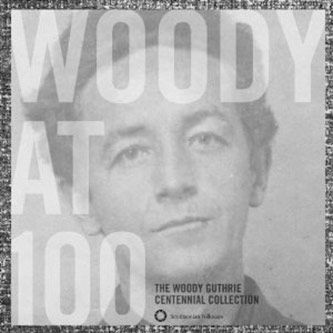
Woody at 100: The Woody Guthrie Centennial Collection (Smithsonian Folkways, 2012)
Not all the music here is new, in keeping with Smithsonian Folkways practice of repackaging material that they have previously released, and in this case, even re-released. Of the forty-five titles on CD 1 and CD 2 of the new Woody at 100 collection, all but six are found on the 1999 reissue compilation, Woody Guthrie: The Asch Recordings, Volumes 1-4, and four of those remaining six appear on other Smithsonian Folkways releases. The new material, the real gems, is found on CD 3, beginning with the four cuts made in Los Angeles in 1937 or 1939. Here Guthrie sings in a youthful, exuberant voice, accompanying himself with strong guitar runs and exceptional harmonica fills. Included are two previously unreleased pieces, "Them Big City Ways" and "Skid Row Serenade," both inspired by Guthrie's experiences in Los Angeles. Radio broadcasts of WNEW's The Ballad Gazette (1945), the BBC's Children's Hour (1944), and WNYC's Folk Songs of America capture Guthrie at the height of his musical proficiency, demonstrating his mastery of the radio medium. Another standout is a nine minute snippet of a live People's Songs Hootenanny with Guthrie, Lee Hays, Pete Seeger, Bess Lomax Hawes, and Cisco Houston that was recorded by Moe Asch sometime in the mid-1940s. The singing is spontaneous and playful, and the hilarious Guthrie/Hays mock debate captures the spirit of these early hootenannies. The CD ends with a touching lullaby for little Cathy, led by Guthrie with Marjorie harmonizing on the chorus, recorded a year before the tragic death of their four-year-old daughter in a fire.
So if you already have the four Guthrie/Asch volumes that contain most of the songs on CDs 1 and 2, is this new package really worth it? Well, if you are one of those Guthrie aficionados who must have it all, and if you've got that do-re-mi, the answer is unequivocally yes. The Los Angeles songs, the radio performances, and live Hootenanny track fill serious voids in the Guthrie recording legacy and together lead to a deeper appreciation of his artistry and activism.
As the Centennial comes to an end and we sift our way through this most recent crop of Guthrie books and recordings we might ask if the historical picture is finally complete. Are we ready to collectively chorus to Woody, wherever he currently rambles, "So Long it's Been Good to Know Ya"? Given his iconic stature in the world of American folk music, the breadth of his output, and the fact that his songs continue to inform and inspire new generations of musicians, the answer is probably no. The Guthrie Archive will continue to be mined from its new home in Tulsa, Oklahoma, where it will be housed in the multi-million dollar Guthrie Center. Rounder Records hopes to release an expanded collection of Guthrie's 1940 Library of Congress recordings next year, while University of Southern California historians William Deverell and Darryl Holter plan to edit a collection of the best Guthrie presentations from the centennial conferences. Stand by Guthrie fans; more is yet to come.






